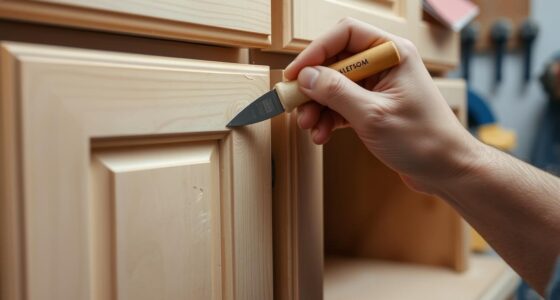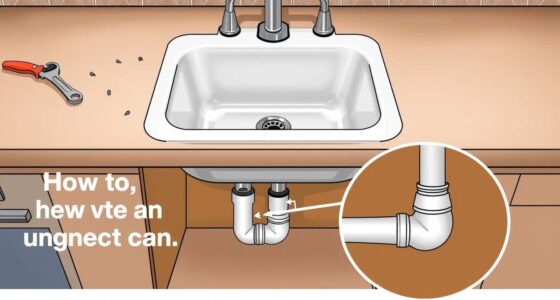When deciding whether to DIY or hire a pro, consider your skills, the project’s complexity, and safety needs. Simple tasks like painting or basic repairs can often be tackled yourself, but complex plumbing, electrical, or HVAC work may require expert help to avoid costly mistakes and hazards. Assess how much time and effort you’re willing to invest, and remember that professional help can save you stress and guarantee quality results. For details on matching projects to your skills, keep exploring.
Key Takeaways
- Evaluate your skill level and experience to determine if a project is within your capabilities.
- Consider the project’s complexity and potential hidden challenges that may require professional expertise.
- Weigh the costs of materials and time against professional fees to decide if DIY saves money or risks costly mistakes.
- Factor in safety concerns, especially for electrical, plumbing, or HVAC tasks, where mistakes can be hazardous.
- Assess the importance of quality, durability, and compliance with codes to determine if hiring a pro ensures better results.

Are you wondering whether to tackle a project yourself or hire a professional? Deciding between the two options often comes down to understanding the cost considerations and skill requirements involved. If you’re trying to save money, you might think DIY is the way to go, but it’s important to weigh whether your skills align with the task at hand. Some projects seem simple on the surface, but hidden complexities can lead to costly mistakes if you’re not properly prepared. On the other hand, hiring a pro might seem expensive upfront, but it can save you money in the long run by ensuring the job is done correctly the first time.
Deciding to DIY or hire a pro depends on costs, skills, and project complexity.
When evaluating cost considerations, you should consider not only the price of materials but also the time you’ll invest. DIY projects often require a significant time commitment, especially if you’re learning as you go. Mistakes can be costly, both in terms of materials wasted and potential damage that might require professional repairs later. For example, attempting electrical work without proper knowledge can lead to safety hazards and expensive fixes. Conversely, hiring a licensed electrician might seem pricey initially, but it gives you peace of mind that the job meets safety standards and complies with local codes. Additionally, understanding the complexities of certain projects can help you determine whether your skills are sufficient for the task. This is especially true for projects involving advanced automotive modifications, which often require specialized tools and expertise. Furthermore, considering the environmental impact and refrigerant management can be crucial for projects involving heating or cooling systems to prevent costly mistakes and environmental hazards.
Skill requirements play an essential role in your decision as well. Some projects demand specialized skills and tools that you might not possess. Painting a wall can be straightforward, but installing complex drywall systems or doing intricate carpentry requires experience. If you lack the necessary skills, you risk ending up with a subpar result that could diminish the value of your home or require costly rework later. Assess your comfort level and experience honestly—if you’re unsure about your ability to handle the task safely and effectively, you should consider bringing in a professional. Recognizing the importance of proper calibration can also help ensure that your project meets quality standards and functions as intended.
Additionally, consider the potential stress and frustration involved. Tackling a project beyond your skill set can be overwhelming, leading to delays and dissatisfaction. Professionals come equipped with the expertise and tools to work efficiently, often completing projects faster and with higher quality. If you enjoy learning new skills and have the time, DIY can be rewarding; but if your goal is to ensure durability, safety, and a polished finish, hiring a pro is often the smarter choice.
Ultimately, weighing cost considerations against skill requirements helps you make an informed decision. It’s about balancing your budget with your abilities and the value of your time and effort. Sometimes, paying for expert help saves money, stress, and future headaches. Other times, a well-planned DIY approach can be satisfying and economical—just be sure you’re honest about your skills and the complexity of the project before jumping in. Considering home energy efficiency and safety standards can also guide you in deciding whether a DIY or professional approach is best for systems like heat pumps.
Frequently Asked Questions
How Do I Assess My Skill Level for a Project?
To assess your skill level for a project, start with a honest skill assessment by reviewing your past experiences and current abilities. Consider your DIY confidence and whether you’ve successfully completed similar tasks before. If you feel unsure or lack experience, it’s better to seek guidance or hire a pro. Be realistic about what you can handle safely and effectively, ensuring quality results and avoiding potential accidents or setbacks.
What Tools Are Essential for DIY Home Repairs?
When considering essential tools for DIY home repairs, start with power tools like a drill, saw, and screwdriver for versatility and efficiency. Don’t forget safety gear such as goggles, gloves, and masks to protect yourself during projects. These tools help you work effectively and safely, making your repairs smoother. Investing in quality power tools and safety gear guarantees you’re prepared to handle various tasks confidently and securely around your home.
How Can I Estimate the Total Cost of a Project?
To estimate your project’s total cost, start by listing all needed materials and checking current material costs online or at stores. Then, consider labor expenses, whether your own or if you plan to hire help. Add these figures together, including any tools or additional supplies. Don’t forget to include a buffer for unexpected costs. This approach gives you a clear idea of the overall budget before you begin.
When Is It Necessary to Get Permits for Home Projects?
You need to get permits when your project involves structural changes, electrical work, or plumbing, as permit requirements vary by location. These legal considerations guarantee safety and code compliance. If you’re unsure whether your project needs a permit, check with your local building department. Skipping permits can lead to fines or issues with future home sales, so always verify if your project falls under required legal considerations before starting.
What Are the Signs That a Project Requires Professional Expertise?
You might think DIY is always doable, but a risk assessment shows some projects need professional help. If a task involves electrical, plumbing, or structural changes, it’s time for a contractor consultation. Signs include complex permits, safety concerns, or if the project exceeds your skill level. Recognizing these indicators helps you prevent costly mistakes and ensures the job is done safely, professionally, and up to code.
Conclusion
Deciding between DIY and hiring a pro demands discernment and dedication. Don’t let doubt dampen your drive; instead, establish your skill level and the project’s complexity. When you weigh the risks and rewards wisely, you’ll choose with confidence, avoiding costly mistakes. Remember, sometimes stepping back and seeking expertise ensures excellence. Embrace the balance between boldness and boundaries, because knowing when to DIY and when to delegate defines your success. Make mindful moves, and your project will flourish!









